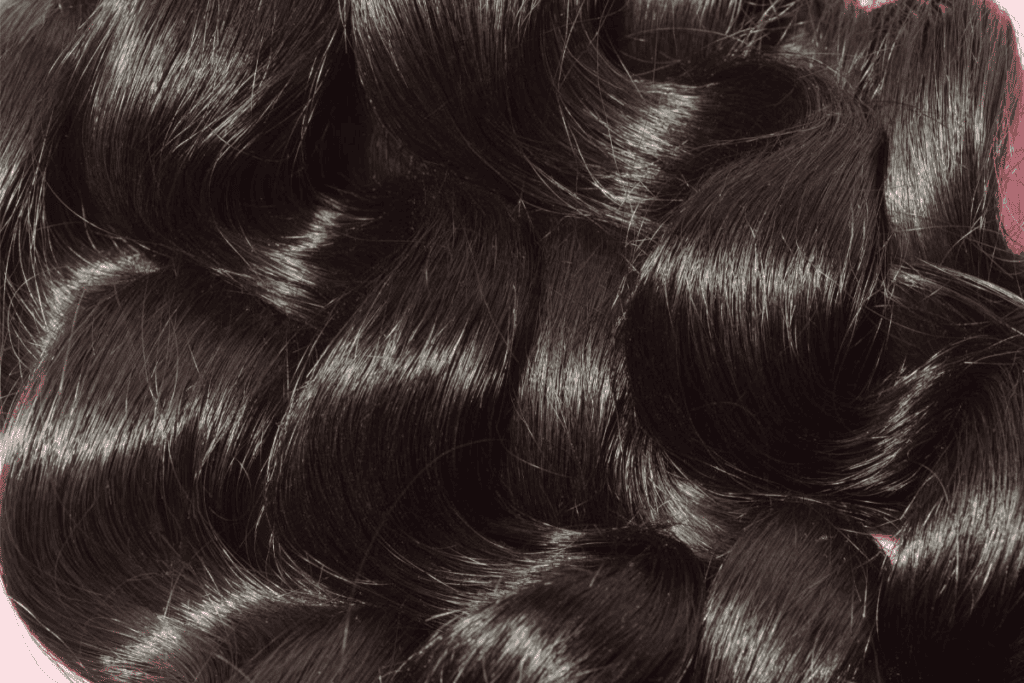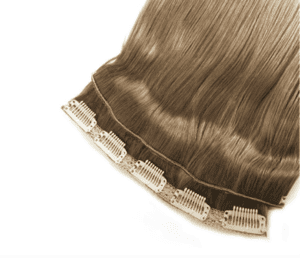
In a world where hair extensions have become an integral part of fashion and personal expression, understanding the science behind these beauty enhancements is more crucial than ever.
From exploring the diverse structures and types of hair to examining the impact of external factors on hair health, this article takes a unique approach that sets it apart from the myriad of generic articles found online.
By weaving together scientific concepts and everyday observations, we create an accessible and engaging narrative that unveils the fascinating intricacies of hair anatomy and physiology.
Whether you're a hair enthusiast or a professional in the industry, this article will equip you with invaluable knowledge to help you make informed decisions and appreciate the true artistry of hair extensions.
What is Hair Structure and Growth?

Hair is a complex biological structure composed of several parts, including the cuticle, cortex, and medulla. All these components play an important role in the growth and appearance of hair.
The cuticle acts as a protective layer for the cortex which contains the pigment melanin that gives our hair its color. The medulla, or innermost layer, helps to regulate temperature and protect against damage.
1. Hair follicle: the origin of hair growth
The hair follicle is the origin of all hair growth and is responsible for the health and growth cycle of immune cells in our hair.
It consists of several layers, including a papilla that contains capillaries that provide nutrients to the follicle.
The follicle also contains sebaceous glands which produce sebum, an oily substance that helps keep our hair and scalp hydrated.
2. Hair bulb: the structure responsible for hair growth
The hair bulb is the structure at the base of hair follicles responsible for producing new hairs.
It consists of several layers, including an outer layer known as the external hair root sheath, which protects newly formed hairs from environmental damage.
It also contains smooth muscle cells that contract when stimulated by nerve endings to aid in the growth process and a papilla containing dermal papilla cells that provide nourishment to stem cells in the follicle.
3. Hair shaft: the visible part of the hair
The hair shaft is the visible part of our hair and the hair shaft consists of of several layers, including an outer layer called the cuticle which helps protect against damage from environmental factors such as UV rays and wind.
The cortex, or middle layer, contains the melanin that gives our own hair pigment, its pigment and texture.
The medulla is the innermost layer which helps regulate temperature and protect body surface and the hair against damage.
Explanation of the hair growth cycle

1. Anagen phase: active hair growth phase
The Anagen phase terminal hair itself, often referred to as the active hair growth phase, plays a crucial role in setting the foundation for healthy hair growth.
During this vital stage, hair follicles actively produce new cells, which push the existing hair strand outwards, allowing it to grow longer.
The average duration of the Anagen phase ranges from 2 to 7 years, with factors such as dietary habits, genetics, and hair care products impacting the length of this growth period.
A balanced diet, rich in essential nutrients like proteins, vitamins, and minerals, can contribute to optimal hair health by providing the building blocks necessary for strong and vibrant hair growth.
Additionally, using proper hair care products that nourish and protect the hair and scalp can further promote healthy growth during the Anagen phase.
By understanding the importance of this critical phase and taking appropriate measures to support hair health, individuals can enjoy stronger, more resilient hair that radiates vitality.
2. Catagen phase: transitional phase
The catagen phase is characterized by a series of physiological changes that prepare the hair follicle for its eventual resting state.
During the catagen phase, the hair follicle undergoes a process called involution, in which it starts to shrink and detach from the dermal papilla, which supplies nutrients to the mature hair follicle.
Consequently, the hair strand, now referred to as "club hair," ceases to grow and is pushed upwards within the follicle.
Both inner root sheath and outer root sheath, which surround and protects the hair shaft, also begin to disintegrate during this phase, allowing the club hair to move freely.
These changes ultimately result in alterations to the hair's texture, as it becomes more compact and assumes a bulb-like shape at the base.
The catagen phase typically lasts for 2 to 3 weeks, but factors such as age, hormones, and genetics can influence the duration of this transition period.
Understanding the intricacies of the catagen phase helps us appreciate the complex biological processes that govern hair growth and contribute to the intricate balance of hair maintenance and renewal.
3. Telogen phase: resting phase

The Telogen phase, commonly known as the resting phase, is the final stage of the hair growth cycle and plays a crucial role in maintaining a healthy balance between hair growth and shedding.
During this phase, the hair follicle remains inactive, and the club anagen hair follicles, which was formed during the catagen phase, is firmly anchored in place.
The Telogen phase typically lasts for around 3 to 4 months, during which time approximately 10-15% of all hairs on the scalp are in this resting state.
It's important to note that hairs in the Telogen phase are more prone to shedding, as they have completed their growth cycle and are gradually being replaced by new hairs growing from the same follicle.
This natural shedding process is essential for the renewal of healthy hair and should not be mistaken for abnormal hair loss.
However, excessive shedding can be a sign of an underlying issue or could be exacerbated by factors such as harsh hair care practices or certain products.
To manage hair during the Telogen phase, it's essential to use gentle hair care products that minimize breakage and avoid any unnecessary stress on the hair, such as tight hairstyles or excessive heat styling.
By understanding the intricacies of the Telogen phase and adopting appropriate hair care practices, individuals can maintain the delicate equilibrium of the hair cycle between growth and shedding while promoting overall hair health.
4. Exogen phase: shedding of old hair
Embarking on a journey to achieving healthy, lustrous hair begins with understanding the intricate process of hair growth and its various phases.
One often overlooked, yet vital phase is the exogen phase, which plays a crucial role in maintaining the balance between hair growth and shedding.
During the exogen phase, old hairs naturally shed from skin surface of the scalp, making way for new growth and ensuring the continuous rejuvenation of your hair.
Embracing the exogen phase as a normal and essential part of the hair growth cycle is key to achieving strong, vibrant locks.
With a thorough understanding of the hair growth process and the right hair care products in your arsenal, you'll be well-equipped to achieve the gorgeous, thriving locks you've always desired.
Hair Quality and Extension Selection

1. Cuticle condition and integrity
As you embark on your hair extension journey, it's essential to understand the importance of cuticle condition and integrity in order to select extensions that are suitable for your hair type.
The outermost layer of the hair shaft, known as the top cuticle layer, is composed of flat overlapping cells that act as a protective barrier against damage and moisture when hair loss occurs.
The cuticle of healthy hair is strong, smooth, and intact, allowing the whole pigmented hair shaft to move freely. Conversely, damaged or weaker cuticles can impede the ability of the hair shaft to expand and contract in response to environmental growth factors in, such as humidity.
This ultimately affects the overall quality of your hair extensions, as hair with a weak cuticle is more prone to breakage and tangling.
Therefore, it's essential to select hair extensions that have been sourced from healthy donors with strong, intact cuticles for optimal results.
Using quality products such as conditioners and treatments to maintain the health of your hair extensions will help ensure they last longer and look more vibrant.
Additionally, using a wide-toothed comb instead of a brush can help to reduce breakage and minimize the risk of damage to your hair extensions. By understanding the importance of cuticle condition, you'll be better equipped to select the right extensions for your needs.
2. Hair texture and thickness

In addition to understanding the importance of cuticle condition when selecting hair extensions, it's important to consider the texture hair density and thickness of your natural hair.
The texture of your hair can range from fine, medium, and thick to coarse in nature and is largely determined by its diameter and circumference.
For example, thin or "fine" hair has a small circumference while thick or "coarse" strands have larger diameters.
By recognizing the distinctions between different textures, you can easily determine which type of extension will blend most seamlessly with your natural locks.
Additionally, considering the thickness or density of your hair is paramount for achieving an optimal result as extensions that are too heavy may cause strain on your scalp.
For those with thin hair, opting for a lightweight synthetic extension that mimics the texture of human hair is recommended.
Conversely, those with thicker strands may benefit from extensions made from 100% real human hair as they offer greater volume and more natural movement.
By taking into account your own hair's texture and thickness when selecting extensions, you can ensure the highest quality results every time.
3. Hair origin and color
When selecting hair extensions, the origin and hair color, of the hair also play an important role.
Human hair extensions can be sourced from a variety of countries, including Russia, Brazil, India, China, and Mongolia.
Each nation has its own unique characteristics when it comes to texture and color which makes it important to be aware of these distinctions before making your selection.
For example: Brazilian hair is generally coarse with a natural sheen while Russian hair is often fine yet still strong and resilient in nature.
Color-wise, Indian hair tends to be darker in shade while Mongolian locks boast a wide range of tones ranging from dark brown to platinum blonde.
Differentiating between synthetic and human hair extensions

When it comes to enhancing your hairstyle with hair extensions, understanding the differences between synthetic and human hair extensions is key to making an informed decision.
Construction and Material
Synthetic Hair Extensions: Made from artificial fibers, such as acrylic or polyester, synthetic hair extensions are designed to mimic the look and texture of human hair. These fibers are often coated with silicone to make them appear more natural and shiny.
Human Hair Extensions: As the name suggests, human hair extensions are made from real human hair, typically sourced from donors in countries like India, Brazil, and Russia. This type of extension offers the most natural look and feel, closely resembling your own hair.
Quality, Durability, and Versatility
Synthetic Hair Extensions: While synthetic extensions have come a long way in terms of quality, they generally don't last as long as human hair extensions.
They are less versatile when it comes to styling, as they cannot be exposed to high heat from styling tools without the risk of melting or damage.
However, synthetic extensions usually hold their style well, even in humid conditions.
Human Hair Extensions: Owing to their natural origin, human hair extensions offer superior quality, durability, and versatility.
They can be styled, dyed, and treated just like your own hair, allowing for a wide range of styling options. With proper care and maintenance, human hair extensions can last for several months or even years.
Maintenance and Styling Options

Synthetic Hair Extensions: Maintenance for synthetic extensions is relatively simple.
However, they require special products designed specifically for synthetic hair care. Additionally, styling options are limited due to their heat sensitivity.
Human Hair Extensions: Human hair extensions require more maintenance, similar to that of your natural hair.
They can be styled with heat tools like curling irons and straighteners, and you can use regular hair care products on them.
Pricing and Installation Methods
Synthetic Hair Extensions: Generally more affordable than human hair extensions, synthetic options are an excellent choice for those on a budget or looking for a short-term style change. Various installation methods are available, including clip-ins, tape-ins, and sew-ins.
Human Hair Extensions: As a premium product, human hair extensions come with a higher price tag. However, the investment pays off in terms of longevity, quality, and styling versatility.
Like synthetic extensions, they can be installed using clip-ins, tape-ins, sew-ins, and other professional methods like fusion or micro-link extensions.
Remy hair vs. non-Remy hair: Understanding the distinction

Remy hair extensions are those that have been carefully processed to ensure the cuticles remain intact and more hair is aligned in a single direction.
This helps to preserve the hair's natural luster, texture, and strength. In contrast, non-Remy hair is made from strands of various hair types whose cuticles oppose one another which can lead to tangling and breakage over time.
Ultimately, understanding the anatomy and physiology of the human body and hair extensions is key for making an educated decision when it comes to buying premium quality hair products for your business or salon.
Knowing how synthetic and human extensions differ as well as the distinctions between Remy and non-Remy hair will help you provide your customers with exceptional service while maximizing profits.
Understanding the Science of Hair Extensions: Make Informed Decisions

At its core, understanding the science of hair extensions is all about making informed decisions to achieve optimal results.
With a thorough knowledge of how human hair grows, along with an appreciation for cuticle condition and choosing extensions suitable to your individual needs, you'll be well-equipped to achieve beautiful, healthy hair that you can be proud of.
Whether you're a salon owner, online retailer, or simply looking to change up your style with extensions, this article has provided you with the essential knowledge needed to make the best decisions for your hair and business.
With all the information at your fingertips, there's no limit to what you can achieve!








